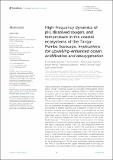| dc.description.abstract | Ocean acidification, deoxygenation, and warming are three interconnected
global change challenges caused by increased anthropogenic carbon
emissions. These issues present substantial threats to marine organisms,
ecosystems, and the survival of coastal communities depending on these
ecosystems. Coastal upwelling areas may experience significant declines in
pH, dissolved oxygen (DO), and temperature levels during upwelling events,
making marine organisms and ecosystems in these areas more susceptible to
ocean acidification and deoxygenation. Understanding the dynamics of pH,
DO, and temperature in coastal upwelling areas is essential for evaluating the
susceptibility of resident organisms and ecosystems to lower pH and DO
conditions occurring during upwelling events. To accomplish this, we used
the pH and the DO loggers to measure high-frequency data for pH and DO,
respectively, over six months in the open ocean and for a 24-hour cycle
within the mangrove, seagrass, and coral reef ecosystems of the Tanga-
Pemba Seascape (T-PS) during the northeast monsoon season. Our findings
revealed the occurrence of multiple upwelling events, with varying durations,
that result in significant declines in pH, DO, and temperature within the
seascape. This is the first study to confirm the occurrence of multiple
upwelling events in the T-PS. Moreover, the study has revealed a pH
threshold value of 7.43 for ocean acidification in the T-PS. This is the first
study to report a threshold value for ocean acidification in coastal upwelling
areas of the Western Indian Ocean (WIO). Furthermore, it revealed that the
extremely low levels of pH that occurred during upwelling events were above
the pH threshold value of 7.43 for ocean acidification, while the extremely
low levels of DO fell below the oxygen threshold value of 4.6 mg/L for
deoxygenation. During upwelling events, seagrass and coral reef ecosystems,but not mangrove ecosystems, demonstrated elevated mean hourly values of
pH and DO compared to those of the open ocean. These findings show that
marine organisms and ecosystems in the T-PS are frequently exposed to
lower pH and DO conditions due multiple upwelling events. However, their
susceptibility to these conditions is reduced to some extent by the presence
of seagrass meadows within these interconnected systems. | en_US |

